
Chapter 35
The Short-Run Trade-Off Between Inflation and Unemployment
TRUE/FALSE
1. In the long run, the natural rate of unemployment depends primarily on the growth rate of the money supply.
ANS: F DIF: 1 REF: 35-0 NAT: Analytic
LOC: Unemployment and inflation TOP: Natural rate of unemployment
MSC: Definitional
2. In the long run, the inflation rate depends primarily on the growth rate of the money supply..
ANS: T DIF: 1 REF: 35-0 NAT: Analytic
LOC: Unemployment and inflation TOP: Inflation MSC: Definitional
3. Short-run outcomes in the economy can be expressed in terms of output and the price level, or in terms of
unemployment and inflation.
ANS: T DIF: 1 REF: 35-1 NAT: Analytic
LOC: Unemployment and inflation TOP: Phillips curve | Aggregate demand and supply
MSC: Applicative
4. Other things the same, an increase in aggregate demand reduces unemployment and raises inflation in the
short run.
ANS: T DIF: 2 REF: 35-1 NAT: Analytic
LOC: Unemployment and inflation TOP: Short-run Phillips curve slope
MSC: Applicative
5. A given short-run Phillips curve shows that an increase in the inflation rate will be accompanied by a lower
unemployment rate in the short run.
ANS: T DIF: 2 REF: 35-1 NAT: Analytic
LOC: Unemployment and inflation TOP: Short-run Phillips curve slope
MSC: Interpretive
6. The short-run Phillips curve indicates that expansionary monetary policy will temporarily raise the
unemployment rate above its natural rate.
ANS: F DIF: 2 REF: 35-1 NAT: Analytic
LOC: Unemployment and inflation TOP: Short-run Phillips curve slope
MSC: Definitional
7. The logic behind the tradeoff between inflation and unemployment is that high aggregate demand puts upward
pressure on wages and prices while raising output.
ANS: T DIF: 2 REF: 35-1 NAT: Analytic
LOC: Unemployment and inflation TOP: Short-run Phillips curve slope
MSC: Analytical
8. Unexpectedly high inflation reduces unemployment in the short run, but as inflation expectations adjust the
unemployment rate returns to its natural rate.
ANS: T DIF: 1 REF: 35-2 NAT: Analytic
LOC: Unemployment and inflation
TOP: Short-run Phillips curve slope | Short-run Phillips curve shifts
MSC: Analytical
9. Fiscal policy cannot be used to move the economy along the short-run Phillips curve.
ANS: F DIF: 1 REF: 35-1 NAT: Analytic
LOC: Unemployment and inflation TOP: Short-run Phillips curve slope | Fiscal policy
MSC: Applicative
8

9 Chapter 35 /The Short-Run Trade-Off Between Inflation and Unemployment
10. If the Fed were to increase the money supply, inflation would increase and unemployment would decrease in
the short run.
ANS: T DIF: 1 REF: 35-1 NAT: Analytic
LOC: Unemployment and inflation TOP: Short-run Phillips curve
MSC: Analytical
11. Friedman and Phelps believed that the natural rate of unemployment was constant.
ANS: F DIF: 2 REF: 35-2 NAT: Analytic
LOC: Unemployment and inflation TOP: Long-run Phillips curve
MSC: Definitional
12. The long-run Phillips curve is consistent with monetary neutrality implied by the classical dichotomy.
ANS: T DIF: 1 REF: 35-2 NAT: Analytic
LOC: Unemployment and inflation TOP: Long-run Phillips curve | Classical dichotomy
MSC: Interpretive
13. The short-run Phillips curve is based on the classical dichotomy.
ANS: F DIF: 1 REF: 35-1 NAT: Analytic
LOC: Unemployment and inflation TOP: Classical dichotomy
MSC: Interpretive
14. The classical notion of monetary neutrality is consistent both with a vertical long-run aggregate-supply curve
and with a vertical long-run Phillips curve.
ANS: T DIF: 2 REF: 35-2 NAT: Analytic
LOC: Unemployment and inflation
TOP: Long-run aggregate supply | Long-run Phillips curve | Classical dichotomy
MSC: Interpretive
15. Although monetary policy cannot reduce the natural rate of unemployment, other types of government policies
can.
ANS: T DIF: 1 REF: 35-2
TOP: Natural rate of unemployment MSC: Definitional
16. A policy change that reduces the natural rate of unemployment shifts both the long-run aggregate-supply curve
and the long-run Phillips curve left.
ANS: F DIF: 1 REF: 35-2
TOP: Long-run Phillips curve | Long-run aggregate supply MSC: Applicative
17. An increase in the natural rate of unemployment shifts the long-run Phillips curve to the right.
ANS: T DIF: 1 REF: 35-2 NAT: Analytic
LOC: Unemployment and inflation
TOP: Long-run Phillips curve | Natural rate of unemployment MSC: Analytical
18. In the long run people come to expect whatever inflation rate the Fed chooses to produce, so unemployment
returns to its natural rate.
ANS: T DIF: 2 REF: 35-2 NAT: Analytic
LOC: Unemployment and inflation TOP: Long-run Phillips curve
MSC: Analytical
19. The analysis of Friedman and Phelps argues that an expected change in inflation has no impact on the
unemployment rate.
ANS: T DIF: 2 REF: 35-2 NAT: Analytic
LOC: Unemployment and inflation TOP: Short-run Phillips curve shifts
MSC: Analytical

Chapter 35 /The Short-Run Trade-Off Between Inflation and Unemployment 10
20. In the Friedman-Phelps analysis, when inflation is less than expected, the unemployment rate is less than the
natural rate.
ANS: F DIF: 1 REF: 35-2 NAT: Analytic
LOC: Unemployment and inflation TOP: Short-run Phillips curve slope
MSC: Applicative
21. According to the Friedman-Phelps analysis, in the long run actual inflation equals expected inflation and
unemployment is at its natural rate.
ANS: T DIF: 1 REF: 35-2 NAT: Analytic
LOC: Unemployment and inflation TOP: Long-run Phillips curve
MSC: Applicative
22. An increase in inflation expectations shifts the short-run Phillips curve right and has no effect on the long-run
Phillips curve.
ANS: T DIF: 1 REF: 35-3 NAT: Analytic
LOC: Unemployment and inflation
TOP: Short-run Phillips curve | Short-run Phillips curve shifts MSC: Applicative
23. A decrease in government expenditures serves as an example of an adverse supply shock.
ANS: F DIF: 2 REF: 35-3 NAT: Analytic
LOC: Unemployment and inflation TOP: Supply shocks
MSC: Interpretive
24. An adverse supply shock shifts the short-run Phillips curve right and the short-run aggregate-supply curve left.
ANS: T DIF: 2 REF: 35-3 NAT: Analytic
LOC: Unemployment and inflation TOP: Supply shocks
MSC: Applicative
25. In most of the 1970s, the Fed's policy created expectations of high inflation.
ANS: T DIF: 1 REF: 35-3 NAT: Analytic
LOC: Unemployment and inflation TOP: US inflation MSC: Definitional
26. The proliferation of Internet usage serves as an example of a favorable supply shock.
ANS: T DIF: 2 REF: 35-4 NAT: Analytic
LOC: Unemployment and inflation TOP: Supply shocks
MSC: Interpretive
27. A decrease in the growth rate of the money supply eventually causes the short-run Phillips curve to shift right.
ANS: F DIF: 2 REF: 35-3 NAT: Analytic
LOC: Unemployment and inflation
TOP: Short-run Phillips curve shifts | Contractionary policy MSC: Analytical
28. The sacrifice ratio is the percentage point increase in the unemployment rate created in the process of reducing
inflation by one percentage point.
ANS: F DIF: 1 REF: 35-4 NAT: Analytic
LOC: Unemployment and inflation TOP: Sacrifice ratio
MSC: Definitional
29. A low sacrifice ratio would make a central bank less willing to reduce the inflation rate.
ANS: F DIF: 2 REF: 35-4 NAT: Analytic
LOC: Unemployment and inflation TOP: Sacrifice ratio
MSC: Interpretive
30. Proponents of rational expectations argue that failing to account for peoples' revised inflation expectations led
to estimates of the sacrifice ratio that were too high.
ANS: T DIF: 1 REF: 35-4 NAT: Analytic
LOC: Unemployment and inflation TOP: Rational expectations | Sacrifice ratio
MSC: Definitional

11 Chapter 35 /The Short-Run Trade-Off Between Inflation and Unemployment
31. The sacrifice ratio of the Volcker disinflation was larger than previous estimates had predicted.
ANS: F DIF: 1 REF: 35-4 NAT: Analytic
LOC: Unemployment and inflation TOP: Volcker disinflation | Sacrifice ratio
MSC: Definitional
32. U.S. monetary policy in the early 1980s reduced the inflation rate by more than half.
ANS: T DIF: 1 REF: 35-4 NAT: Analytic
LOC: Unemployment and inflation TOP: Volcker disinflation
MSC: Definitional
SHORT ANSWER
1. In the long run what primarily determines the natural rate of unemployment? In the long run what primarily
determines the inflation rate? How does this relate to the classical dichotomy?
ANS:
In the long run the natural rate of unemployment is primarily determined by labor market factors including
government policy concerning minimum wages and unemployment benefits. In the long run inflation is primarily
determined by money supply growth. These determinants are consistent with the classical dichotomy which states
that real and nominal variables are determined independently.
DIF: 2 REF: 35-0 NAT: Analytic LOC: Unemployment and inflation
TOP: Inflation | Natural rate of unemployment | Classical dichotomy
MSC: Definitional
2. Are the effects of an increase in aggregate demand in the aggregate demand and aggregate supply model
consistent with the Phillips curve? Explain.
ANS:
Consider what happens when the aggregate-demand curve shifts. For example, suppose there is an increase in
aggregate demand. The aggregate demand and supply model shows that prices and output will rise. Rising prices
mean that there is inflation. Rising output means falling unemployment. Thus, a shift in the aggregate-demand curve
along the aggregate-supply curve corresponds to a movement along the Phillips curve.
DIF: 2 REF: 35-1 NAT: Analytic LOC: Unemployment and inflation
TOP: Aggregate demand and supply | Short-run Phillips curve shifts
MSC: Analytical
3. The Phillips curve and the short-run aggregate supply curve are closely related, yet one slopes downward and
the other slopes upward. Discuss.
ANS:
The Phillips curve shows the relation between inflation and unemployment. The short-run aggregate-supply curve
shows the relation between the price level and output. When aggregate demand increases, the price level and output
rise. The rising price level means that inflation has increased. The rising level of output means that firms will hire
more workers so that the unemployment rate falls. Thus, the model implies that inflation and unemployment are
inversely related as the Phillips curve indicates. Real GDP and the unemployment rate move in the opposite
direction. So it is consistent to have an upward sloping aggregate supply curve with output on the horizontal axis
and a downward sloping Phillips curve with unemployment on the horizontal axis.
DIF: 2 REF: 35-1 NAT: Analytic LOC: Unemployment and inflation
TOP: Short-run Phillips curve | Short-run aggregate supply MSC: Analytical

Chapter 35 /The Short-Run Trade-Off Between Inflation and Unemployment 12
4. Explain the connection between the vertical long-run aggregate supply curve and the vertical long-run Phillips
curve.
ANS:
Both reflect the classical dichotomy. The vertical long-run aggregate supply curve says that, in the long run, the
economy will be at its natural rate of output, and that this is the same no matter what the price level. The natural rate
of output depends on the natural rate of unemployment. The vertical Phillips curve says that, in the long run, the
economy will be at the natural rate of unemployment (corresponding with the natural rate of output), and that this is
the same no matter what the inflation rate. Both curves are consistent with the classical dichotomy that says real
variables are not affected by nominal variables.
DIF: 2 REF: 35-2 NAT: Analytic LOC: Unemployment and inflation
TOP: Long-run Phillips curve | Long-run aggregate supply MSC: Analytical
5. Suppose that the Fed unexpectedly pursues contractionary monetary policy. What will happen to
unemployment in the short run? What will happen to unemployment in the long run? Justify your answer
using the Phillips curves.
ANS:
In the short run, unemployment will rise, because, contractionary policy reduces actual inflation and so moves the
economy down along the Phillips curve. In the long run, the economy will return to its natural rate of unemployment
as a reduction in expected inflation shifts the short-run Philip curve shifts left.
DIF: 2 REF: 35-2 NAT: Analytic LOC: Unemployment and inflation
TOP: Phillips curve | Contractionary policy MSC: Analytical
6. What did Friedman and Phelps predict would happen if policymakers tried to move the economy upward
along the Phillips curve? Did the behavior of the economy in the late 1960s and the 1970s prove them wrong?
ANS:
Friedman and Phelps predicted that, over time, people would come to expect higher inflation, so the short-run
Phillips curve would shift right. When this happened, unemployment would go back to its natural rate, but inflation
would be higher. The behavior of the economy in the late 1960s and the 1970’s was consistent with their theory.
Inflation rose but unemployment did not remain low.
DIF: 2 REF: 35-2 NAT: Analytic LOC: Unemployment and inflation
TOP: Long-run Phillips curve MSC: Analytical
7. Some countries have inflation around or in excess of 8 percent. Suppose that the sacrifice ratio is 2.5. What is
the cost of reducing inflation from 8 percent to 2 percent? In your answer, define the sacrifice ratio and
explain how you found the cost of inflation reduction.
ANS:
The sacrifice ratio gives the annual percentage decline in output required to reduce the inflation rate 1 percentage
point. The sacrifice ratio is 2.5 so if a country with 8 percent inflation wants to reduce it to 2 percent it will have a
reduction in output equal to 2.5 times 6 percent = 15 percent of annual output.
DIF: 2 REF: 35-4 NAT: Analytic LOC: Unemployment and inflation
TOP: Short-run Phillips curve | Sacrifice ratio MSC: Applicative
8. Why does a downward-sloping Phillips curve imply a positive sacrifice ratio?
ANS:
A downward-sloping Phillips curve implies that as a government acts to decrease inflation, unemployment
increases. Increased unemployment leads to lower output. So the Phillips curve implies that inflation reduction
requires a short-run decrease in output, as does a positive sacrifice ratio.
DIF: 2 REF: 35-4 NAT: Analytic LOC: Unemployment and inflation
TOP: Sacrifice ratio | Short-run Phillips curve slope MSC: Analytical



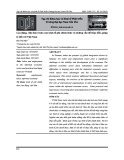
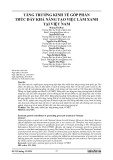
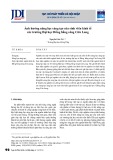

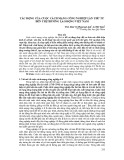
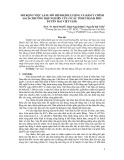
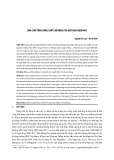
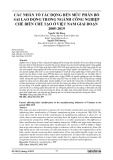



![Bài tập Kinh tế vi mô kèm đáp án [chuẩn nhất]](https://cdn.tailieu.vn/images/document/thumbnail/2025/20250923/thaovu2k5/135x160/19561758679224.jpg)











